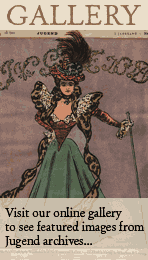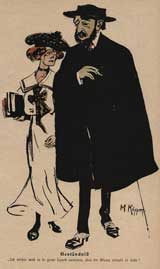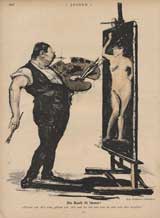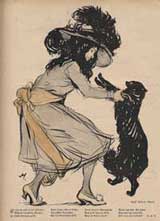The Beginning of a Legend
In Munich, Bavaria, one of the German states, a young man named Georg Hirth who followed Henry Von de Velde started a magazine with the intention of supporting the arts and crafts movement as it spread throughout Bavaria and the other German speaking states.
Within its slim 20-page-or-less weekly format, Jugend published works on art and literature, reproducing paintings, drawings, and other fine artworks by up and coming young artists whom the editors favoured. Though to the modern eye the artwork seems vastly dissimilar in style, there were common elements throughout, and the style of art selected by the Jugend editors as a whole came to be known as Jugendstil. This style was distinct from the other arts and crafts movements in that it focused on Germanic themes and mythologies, providing reinforcement for the unification of the German states.
Jugend became wildly successful, first in Munich and then throughout Germany. Its covers were works of art in themselves, decorated with colourful and fashionable artwork in lithographic tones; Jugend was among the first generation of magazines to use unique artwork extensively on its front cover and throughout its pages. Its information on fashionable clothing and other styles throughout Europe appealed to both women and men. It contained witty caricatures, original prose, and advertisements of the newest products decorated in Jugendstil. One might look at Jugend as a blend of Vogue Magazine and The New Yorker.
Another term for the arts that found their way into Jugend's pages, as well as similar magazines throughout Europe, was "fin-de-siecle," or "end of the century" art.
Within its first seven years Jugend featured over 250 artists, including both professionals and talented amateurs. Most of these artists, upon publication, were unknown, and all of them were closely associated with Munich. More importantly, for several artists like Ernst Barlach, Jugend was the first place their works were presented.
Which is another important point. Up until the time of Jugend and similar magazines, an artist who wished to gain notice hung his or her work at a gallery or at an art show. But new technologies in printing enabled publishers to create cheap replicas of artwork, copy it, and duplicate it onto newsprint. Artists who had formerly gone unnoticed, or who were seen only by the few who came to the art show, were suddenly in a position to become famous, to receive exposure not only to the very wealthy but to the newly comfortable. An entire new market was opened to artists by Jugend.
Yet Jugend's publisher Georg Hirth did not want the style it closely adhered to named after the magazine; he felt the styles carried in Jugend were too diverse to be described by a single narrow term. This wish was to no avail; today, Jugend is immortalized by the movement that carries its name, jugendstil.






